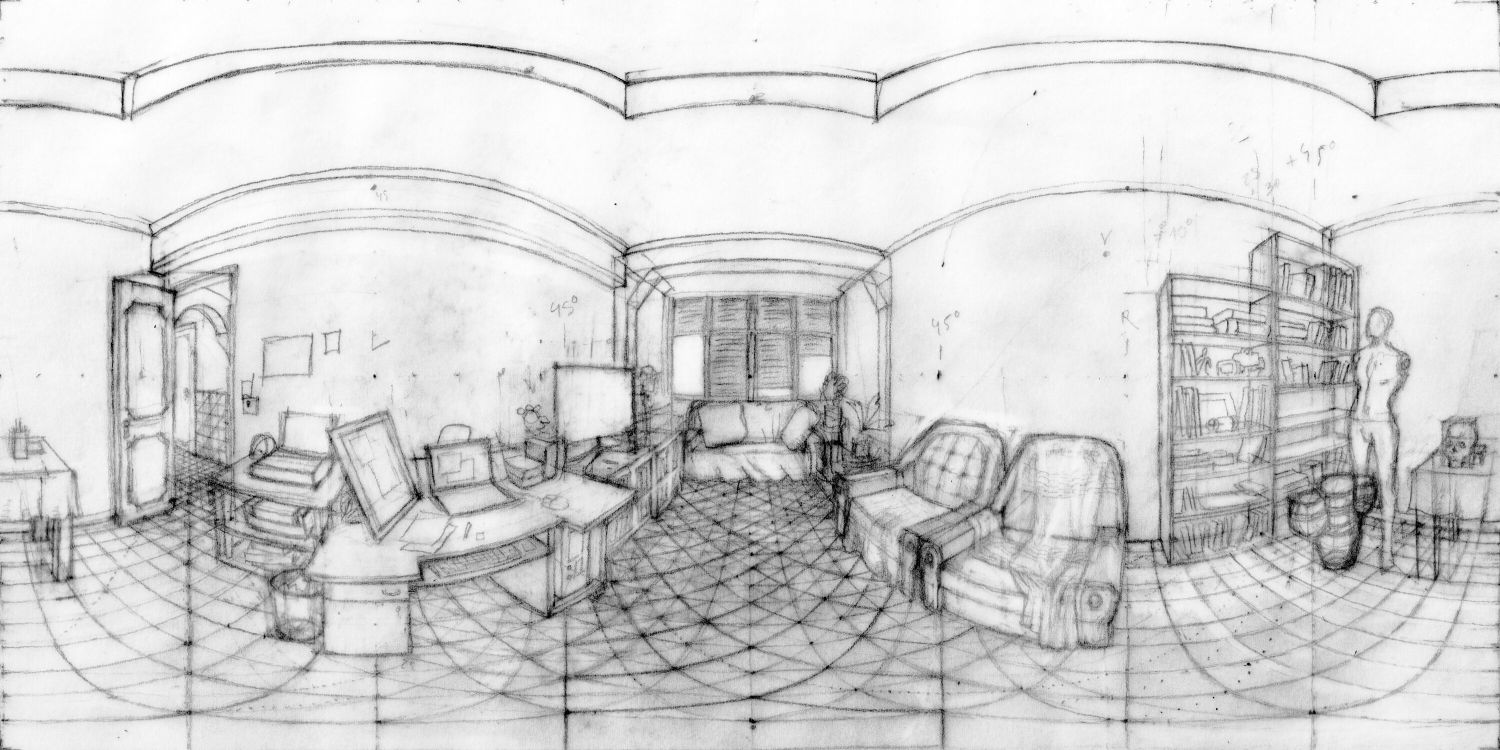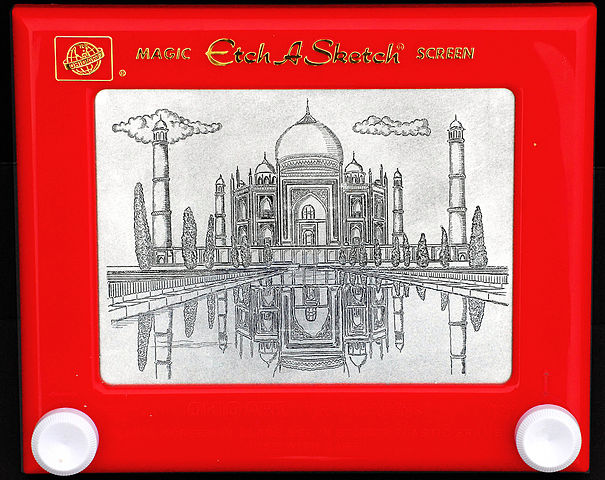

Note: If you are here because of my iLRN 2021 workshop, I have a page of instructions for you here. You may also find it useful watch my equirectangular tutorial videos, especially this one and this one. You don't have to, but it will give you a head start.
Eq A Sketch 360 is an experimental program for sketching equirectangular spherical perspectives. You can download the current version here:
Eq A Sketch 360 for Windows 64 bit - version dated 21-08-2022
It comes as a zip file. No installation, just unzip and run the .exe file inside. Currently the program runs at a fixed 1800x900 resolution. You can change that by editing a simple setup file (see the README file in the zip).
What's new:
(4 dec. 2020): You can now change resolution via a config file (see README file).
(13 dec. 2020): You can now draw on a transparent layer over a photo background and save the drawing separately as a transparent png file.
(13 may 2021): Multiple small bug fixes. You can use ALT+arrows instead of CTRL+arrows to set reference points. Convenience for Mac users.
(21 aug. 2022): Fixed crashes while using Undo and problems with high resolutions. Both due to problems with the Java JDK.
You can also download versions for MAC and Linux (usually somewhat older):
Note: I don't have Linux installed, so I just exported this and I hope it works. Let me know.
Note on 20 may 2021: The previous macOS version was not working correctly in some systems because of an issue related to the Java installation. So please download the new version and let me know if you run into any problems. I don't have full access to a Mac so I appreciate any detailed bug reports so I can get on it as soon as possible.
This is experimental, alpha stage software, so run it at your own risk and expect bugs. It is free of charge, and will be open source once I clean it up - this is a spare time job for me, so it's ready when it's ready.
The program is both a production tool for digital equirectangular drawings and a teaching tool for handmade (paper and pencil) equirectangular drawings.
It has two main features (Slide-and-Snap!):
Slide: A sliding grid. This helps you to measure your constructions. It also helps you to learn the sliding grid method for analog drawing on tracing paper.
Snap: An equirectangular straightedge, i.e., snap-on tool to easily draw the equirectangular line between two given points. This is the equirectangular equivalent of a straightedge for drawing equirectangular lines.
If you know equirectangular perspective you will understand that these tools are game changers with regards to the old fixed grid method. They allow you to draw any line (not just horizontals and verticals), to take measurements, and therefore to do real perspective constructions. You can do anything you used to do with classical perspective!...
...but only if you know the rules of equirectangular perspective. That is deliberate. I want to both motivate you to learn them and to make it easier for you. Without kowing the rules the program is mostly useless. Eq A Sketch 360 is about what you do, not what it does.
The sliding grid tool is mostly a didactic tool (but also a measuring tool). It came from a need of a proper teaching tool to use in my workshops. Although in these workshops I taught an "analog" method (using printed sliding grids under tracing paper) I needed a digital tool to easily display my operations to the whole room.
The equirectangular straightedge tool is instead a production tool. Although the sliding grid allows you to draw any equirectangular line in principle, it is a pretty slow method. When using computers it is much more efficient to just choose two points and let the computer find the line through them. This, however, was a missing feature in the existing equirectangular drawing programs. Michael Scherotter, the author of the very nice equirectangular drawing program, Sketch 360 challenged me to implement such a feature (in fact I had meant to before, but was lazy about it - Michael's challenge kept the problem alive in my busy schedule). It is no rocket science - it's just a cartographic problem, mostly - but somehow the solution seemed both unavailable in the literature and in current drawing software, so I solved it and implemented it in Eq A Sketch 360. I will make the solution available in a paper, which I hope will be useful to both Michael and other developers.
The name Eq A Sketch 360 is a homage to the old Etch a Sketch toy, invented by André Cassagnes in the 1960s, that had two knobs with which you could draw only horizontal and vertical lines. From these humble tools you could construct very complex results (see below).

In a similar way, Eq A Sketch draws horizontal and vertical line segments in equirectangular spherical perspective, but this is deceiving in a way: in fact, as shown in one of my papers, these "horizontals" are geodesics that contain all non-vertical lines (not necessarily horizontal) inside them. I hope that from these simple tools you will also be able to create great and complex objects of art.
I'll be very interested in knowing of your expiences with my software, so feel free to email me or contact me on facebook. Bug reports are also welcome.
I wrote a paper on Eq A Sketch 360 which shows how to calculate the images of equirectangular geodesics. Please cite it as:
Araújo, A. B. (2019). Eq A Sketch 360, a Serious Toy for Drawing Equirectangular Spherical Perspectives. Proceedings of the 9th International Conference on Digital and Interactive Arts, Article 27, 1–8. https://doi.org/10.1145/3359852.3359893
I keep updated author's versions available for free in my institution's server. The current version can be found here. It dates from 31 May 2020 and includes the following correction to the published version: on page 4, in the expression for c, the last factor should read sin(\varphi_2) and not sin(\varphi_1).
Drawings created with Eq A Sketch 360 can be viewed as VR panoramas. Note that the app saves two versions of each drawing: tiff and jpeg. Use the tiff for repeated editings, but use the jpeg for visualization.
At this moment I haven't integrated a VR panorama viewer into Eq A Sketch 360. As of August 2020 I recommend the use of the free FSP viewer on the desktop. It can be found at http://www.fsoft.it/FSPViewer/. On Windows, just right click on the jpeg you saved from Eq A Sketch 360, and the viewer will appear as an option for opening it.
If you prefer to view your panoramas online you can view them on flickr by just uploading it with the #equirectangular tag. For facebook you will need an extra step:
Placing VR panoramas on facebook requires injection of the correct EXIF data. An easy way to do it online is through the Thexifer web app.
You can for instance choose Make as "RICOH" and Model as "RICOH THETA S".
An alternative, quicker way to do it is with The 360 Toolkit, a web site that is also very practical for converting between equirectangular perspective and cubemaps.